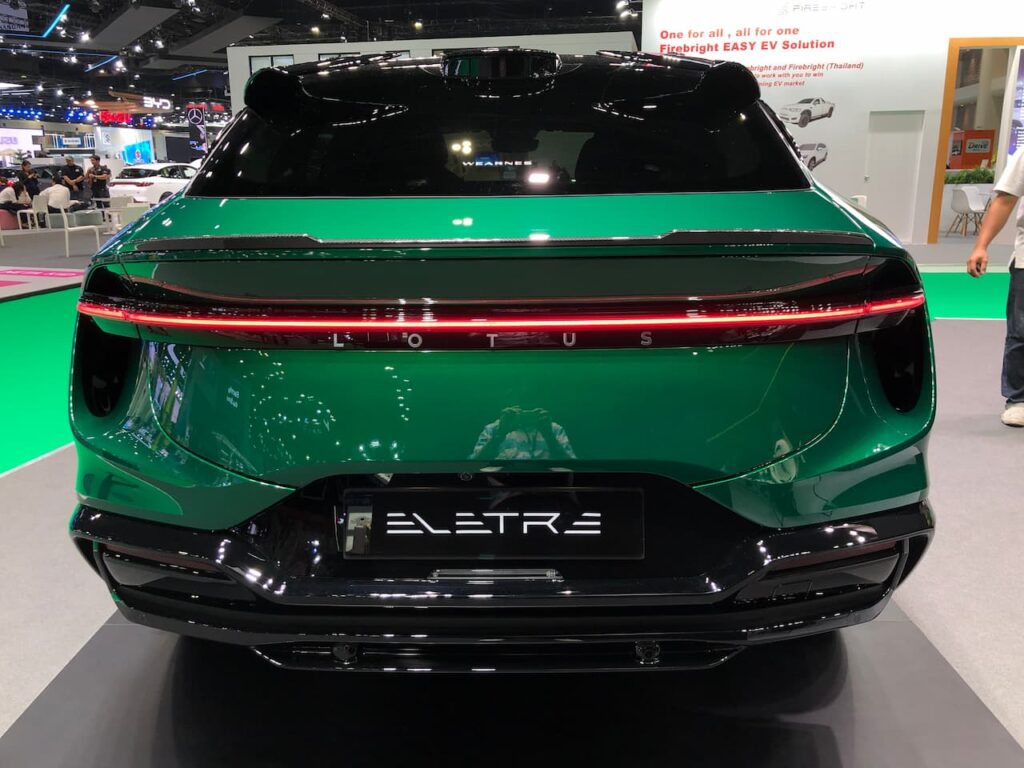After Porsche, Lamborghini, Aston Martin, and Ferrari, Lotus is the next sports car brand lured by the high-profit margins and sales volumes of SUVs. With the Eletre, the company is changing its course of business, targeting mainstream car buyers along with driving enthusiasts, and while at it, it has kicked off its transition to EVs.
Owned by China’s Geely Holding Group and Malaysia’s Etika Automotive, Lotus’s Eletre is Asia’s answer to the Tesla Model X, which holds the pole position in the large high-performance electric SUV segment. At the 2024 Bangkok International Motor Show in March, I saw the all-electric Lotus SUV on display, and I took the chance to learn what’s coming to American customers in Q4 2024.
Design
Lotus says the Eletre’s design was led by its UK design studios in Warwickshire and Hethel, but in my opinion, it has more attributes of a fast Chinese SUV than a vehicle from Britain. The quirkiness created by the split headlamps and the full-width ribbon light strip at the rear contribute to this feeling in first glance.

I do like the dynamic elements that scream performance throughout the vehicle. Be it the concave nose that gives the front an aggressive look, the muscular haunches and extremely raked D-pillar that lend it a powerful crouched stance, or the carbon fiber ‘floating’ split roof spoiler that reminds me of race car winglets from the motorsport world, it’s distinctive!
On a closer look, the Eletre has more that underscores its performance roots, such as two exit vents for letting the air pass through the hood in the front; air pass-throughs along the front wheel arches, behind the rear wheels, and at the top of the D-pillar on the sides; and a flush-fitted tailgate spoiler that emerges only when needed.


The Eletre is quite sophisticated as well. I think the interconnecting triangular petals that Lotus has integrated subtly in the active front grille, the illuminated, flush-fitted door handles, and the 23-inch wheels with carbon-fiber inserts present the Eletre as a classy vehicle. Overall, I feel it definitely boasts a head-turning exterior.
Lotus assembles the Eletre in Wuhan (Hubei Province), China. After spending time closely looking at its exterior, I noticed that its panel gaps were aligned well. Despite its low and sloping roofline, its long and wide body assert it with the sensibilities of a large (E-segment) SUV.


Interior
Lotus collaborated with Danish textile company Kvadrat for the interior of the Eletre. When I stepped into the vehicle, I was strongly reminded of a few other Chinese electric SUVs because of the emphasis on minimalism and digitalization, the trends that most global automakers, including the German Big Three, are also embracing. However, there’s little not to love about the Eletre’s cabin, both aesthetically and otherwise.
The first thing that had my attention was not the 15.1-inch one-billion-color OLED central touchscreen but the floating wing on the dashboard. Lotus had removed its central section as part of its signature light-weighting measures, and along with the ledge-like extensions, this part reminded me of the split roof spoiler. I felt that the light blade positioned within a ribbed channel below this surface accentuated its floating look.


The 15.1-inch HD OLED central touchscreen is no less dramatic, as it can be slid back up and made to face the roof. Knowing the Snapdragon 8155 7nm SoC powers it, I expected it to be snappy. Already tempted by its stunning graphics, I used it for some time and found that was indeed the case.
The infotainment system had sharp graphics and an intuitive menu. I noticed no lag whatsoever in the software while switching between menus and making selections. The display can get very bright, making information easily readable in a bright environment, and it offers high contrast, too. The buttons and switches in the interior offer tactile feedback. The steering wheel with an electrically adjustable column was compact and felt grippy.


The overall quality of the materials was good, and the Nappa Leather upholstery was particularly smooth. I liked the material used on the pillars and headliner more due to their velvety touch. The storage box in the center console could’ve been bigger. I felt this need because the configuration I saw loses the abundant free storage space because of its optional 2,160-watt, 23-speaker, KEF Reference audio system.
Lotus offers the Eletre with both glass-based regular mirrors and camera-based virtual mirrors, and this Galloway Green-painted unit had the latter. The digital mirrors added to its sleek look on the outside. Inside, there were six-inch displays built into the front doors, and I noticed that they gave a crisp and clear view of the rear.

I’m 5’7” tall, and I had no issue with ingress or egress. The driver’s seat automatically moved back to make more room and make ingress easy for me, and once I closed the door after I had sat, it moved back to the pre-set position. The doors unlock electronically, but they don’t swing open electrically.
I felt nicely tucked in the driver’s seat, as the side bolster adjustable side bolsters were pretty supportive. I had 6.5 inches of headroom left in my preferred position. In the lowest setting, about 8-9 inches of headroom was remaining, so I think tall people would also be able to sit in the front of the Eletre’s cabin comfortably. I had good under-thigh support and didn’t notice any issue with the lumbar support.

Lotus offers the Eletre in 4- and 5-seat versions and equips the former with two individual seats and a floating center console in the rear. This particular unit was the 5-seat version. Thus, there were no individual seats with a thigh cushion extender and other fancy equipment. Lotus had installed a more practical bench here.
I found under-thigh support lacking, and I think taller passengers would notice that even more. The angle of the backrest was electrically adjustable, though. I had sufficient legroom and plenty of knee room. The rear doors also unlock electronically and require a manual release.

Driving Impressions
The Lotus Eletre has a 112 kWh battery pack and is available in three dual-motor AWD variants internationally – standard, S, and R. The U.S. is receiving the standard and R versions. The former produces 450 kW (603 hp) and 710 Nm (524 lb.-ft.) of torque, and can do a 0-62 mph sprint in just 4.5 seconds. The Eletre R generates a whopping 675 kW (905 hp) and an astounding 985 Nm (727 lb.-ft.) of torque, allowing it to hit 62 mph from a standstill in just 2.95 seconds. I expect the Eletre to deliver 280-290 miles of EPA-est. range, and the Eletre R to travel up to 210-220 miles (EPA) on a full charge.
| Lotus Eletre specifications | Value |
| Length (in. / mm) | 200.9 / 5103 |
| Width with rear view cameras (in. / mm) | 84 / 2135 |
| Width with rear view mirrors (in. / mm) | 87.8 / 2231 |
| Height (in. / mm) | 20 in. wheels: 64.2 / 1,630 22 in. wheels: 64.4 / 1,636 23 in. wheels: 64.4 / 1,636 |
| Wheelbase (in. / mm) | 119 / 3019 |
| Seating Capacity | 4 / 5 |
| Cargo Space with rear seats folded (liters / cu. ft.) | four-seater: 611 / 21.6 five-seater: 688 / 24.3 |
| Motor | Dual motor AWD |
| Transmission | Eletre: Single-speed Eletre S: Single-speed Eletre R: Two-speed |
| Power (kW / hp) | Eletre: 450 / 603 Eletre S: 450 / 603 Eletre R: 675 / 905 |
| Torque (Nm / lb.-ft.) | Eletre: 710 / 524 Eletre S: 710 / 524 Eletre R: 985 / 726 |
| 0-62 mph Acceleration Time (seconds) | Eletre: 4.5 Eletre S: 4.5 Eletre R: 2.95 |
| Top Speed (mph) | Eletre: 160 Eletre S: 160 Eletre R: 165 |
| Battery Pack Capacity (kWh) | 112 |
| AC Charging Power (kW) | 22 |
| DC Charging Power (kW) | 350 kW |
| 10-80% DC Charging Time (minutes) | 20 |
| WLTP Range (mi) | Eletre: 373 Eletre S: 373 Eletre R: 304 |
Owners and experts who’ve tested the car would also tell you that the Eletre doesn’t feel neck-breaking quick initially, although Lotus says that’s on purpose, keeping in mind many customers will be owning a Lotus and potentially even an EV for the first time. If the driver doesn’t floor the accelerator pedal abruptly and drives in a civilized manner, it’s rather smooth. The air suspension does a good job of ironing out bumps and potholes.

The Eletre R doesn’t feel as quick as expected, as Lotus seems to have tuned its powertrain to unleash all its might progressively. Some reviewers also feel that it’s jumpy, and at times, struggles to keep its front end in the right direction. The power delivery and driving dynamics appears to be an area of improvement for a more confidence-inspiring drive.
The Eletre is the first Lotus featuring an electric power-assisted steering, which feels responsive. Here, feedback is an area that can be improved upon. With a curb weight of up to 2,740 kg, which converts to over 6,000 lbs., the Eletre is quite heavy, and that weight can be felt in the corners and when braking. The synchronization of the regenerative braking system and the friction brakes feels well sorted.
Pricing
The Lotus Eletre is priced at $107,000 for the standard model, and at $145,000 for the ‘R’. Prices exclude taxes, registration, delivery, processing and handling fees. Cars arrive at U.S. dealers in Oct-Dec 2024, and order books are open.
Lotus Eletre FAQs
What is the Lotus Eletre’s release date?
The Lotus Eletre will be launched in the U.S. in Q4 2024. Order books are open.
What will be the Lotus Eletre’s price?
The Lotus Eletre is priced starting at USD 107,000 (excl. taxes & misc fee)
Which models will challenge the Lotus Eletre?

I got my Master’s in Business Management & Administration and have been an International Automotive News Editor since 2014. I’ve traveled to global motor shows and automotive events, driven various types of vehicles, and focused on hybrid and electric cars in the last 4 years.

Comments are closed